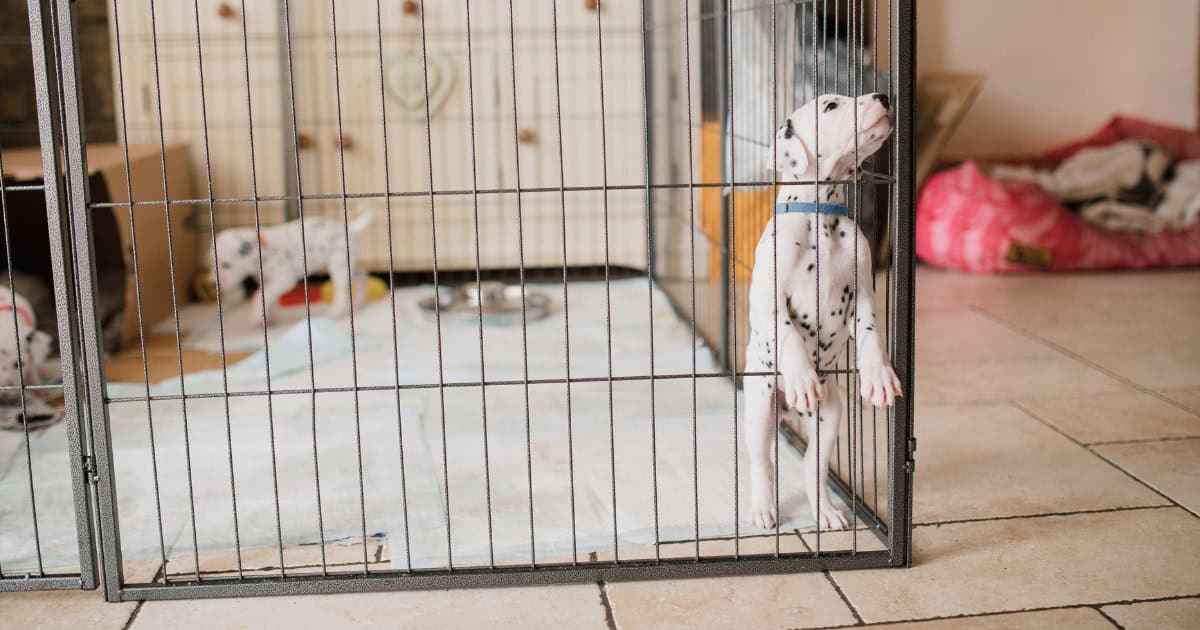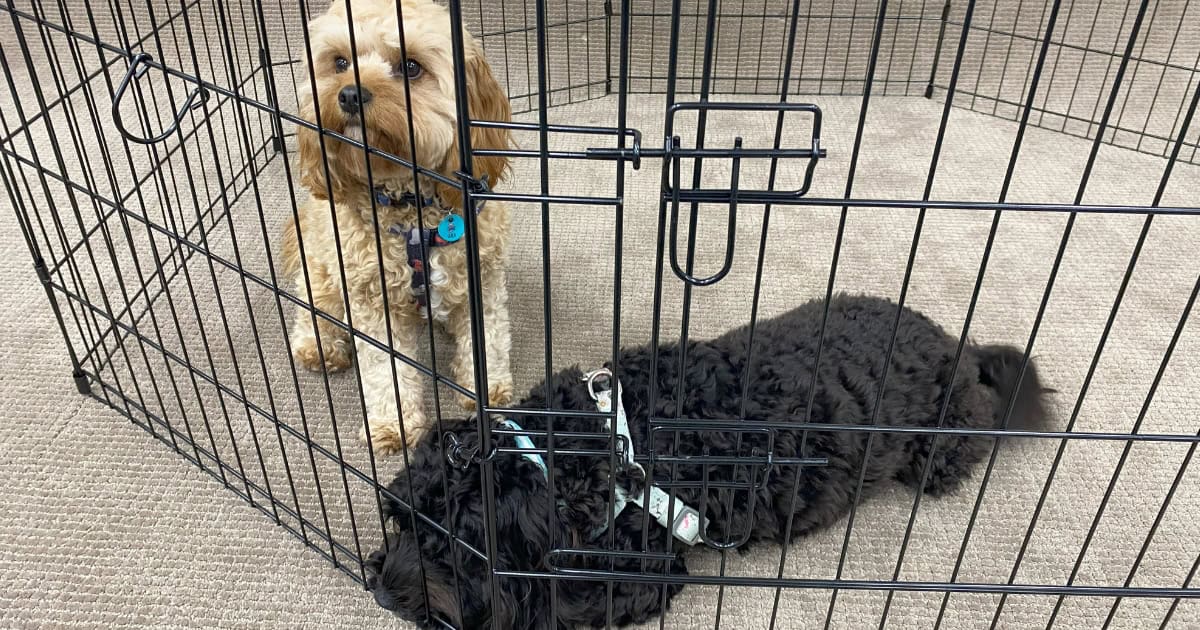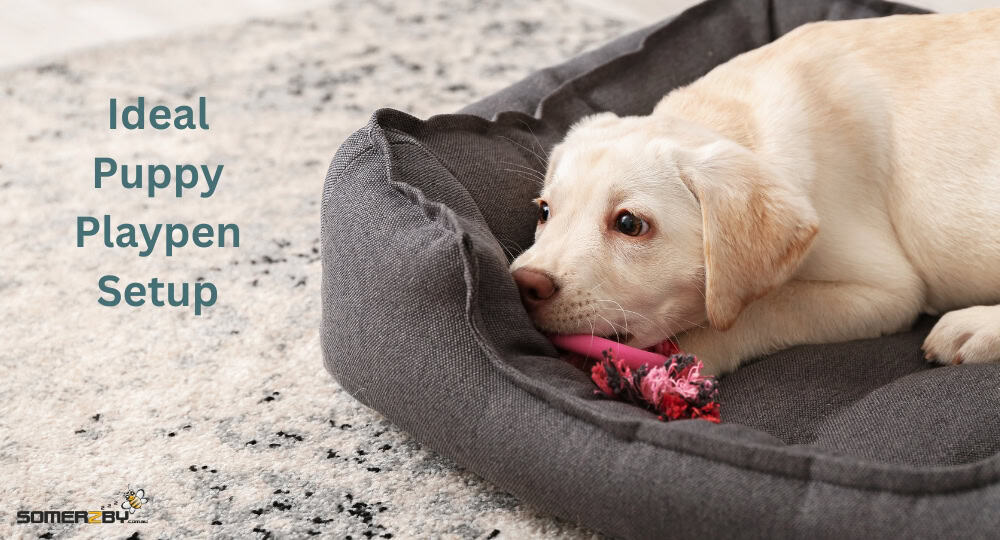Dogs, Info Guides
Aussie Guide to the Ideal Puppy Playpen Setup
Embark on a journey to create the perfect haven for your new puppy with our comprehensive guide to puppy playpen setup. From selecting the ideal enclosure to choosing engaging toys, join us in crafting a space where boundless joy and canine curiosity come together.
Creating a puppy playpen setup for your pup might seem like another chore on the list. Trust me, a playpen is an absolute must-have for any pup. It not only keeps our cheeky little mates safe but also helps them learn and grow.
In this piece, we’re going to unravel everything from why playpens are important for puppies, what makes an ideal one, where to place it in your home and even how to train your puppy in using their new space properly.
I’ve put these play pen tips to the test with my own Cavoodle puppies Piper and Luka, and they work a treat! So hang about – you won’t want to miss this.
- Understanding the Importance of a Puppy Playpen
- Essential Elements of an Ideal Puppy Playpen Setup
- Choosing the Right Location for Your Puppy Playpen
- Common Mistakes in Setting Up a Puppy Playpen
- Essential Play Pen Items
- Training Your Puppy to Use the Playpen
- Maintaining Your Puppy’s Playpen
- Transitioning Out of the Playpen
- Toni’s Wrap
Understanding the Importance of a Puppy Playpen
A puppy playpen, such as the Somerzby Arena playpen, serves as more than just an enclosed space for your furry companion.
It functions as a safe haven where they can freely explore, play, and rest without getting into any trouble.
The significance of having a puppy playpen lies in its impact on a puppy’s growth. This controlled environment allows them to develop independence while providing you with peace of mind, knowing that they are secure.
Additionally, playpens assist in establishing routines and setting boundaries from an early stage. They also give you control over what your puppy can chew or swallow, thereby reducing the risks associated with ingestion hazards.
This confinement area is essential for making sure your pup develops into a balanced grown-up pooch.
It supports their healthy physical and mental development during those crucial first months. Puppy playpens can also be beneficial in assisting with crate training.
While crate training involves acclimating a puppy to a crate, a playpen complements this process by providing a larger confined space where the puppy can move around, play, and have designated areas for eating and resting.
Essential Elements of an Ideal Puppy Playpen Setup
When constructing a puppy playpen, ensure that your pup’s wellbeing and security are taken into consideration. Here are some key elements:
Suitable Size
A good playpen should give your pup plenty of space to move around. It shouldn’t be so small that it restricts their movement but not so big they feel lost.
Durable Material
The material needs to withstand the antics of a playful pup. Strong metal wire or heavy-duty plastic are often better choices over pop-up playpens.
Ease Of Cleaning
Cleanliness is important for your puppy’s health. Look for materials that can be easily wiped down or washed.
Remember, each dog has unique needs, so tailor these suggestions based on what suits them best.
Choosing the Right Location for Your Puppy Playpen
When you’re ready to set up your puppy’s playpen area, location is everything. Choose an area that not only has enough room but also offers a secure and pleasant atmosphere for your pup.
Pick a spot that gets enough light but isn’t directly in the sun. Puppies need their vitamin D, but they can get overheated if left under direct sunlight too long.
Avoid areas with heavy foot traffic or noise that might scare your little mate. A quieter corner of the living room could be perfect.
Choose a spot for your pup that allows them to observe and listen to you regularly, while still providing enough peace and quiet.
But remember, pups need quiet time away from all distractions to rest and grow properly.

Common Mistakes in Setting Up a Puppy Playpen
Size
Picking the wrong size playpen is a common error. A tiny pen can cramp your pup, but an oversized one may not provide the security they need.
Location
Placing it in high-traffic areas might stress out your puppy with constant distractions. Instead, pick a quiet corner that still lets you keep an eye on them.
Extended Confinement
Mistaking puppy pens as cages and leaving pups inside for a long time isn’t good either. Puppies also need social interaction and physical exercise outside their pens to grow healthily.
Essential Play Pen Items
Potty Pads or Litter Box
Incorporating a designated potty area within your puppy playpen setup, complete with strategically placed pee pads, not only helps the potty training process but also reinforces positive habits and helps keep the play space clean.
Comfy Bed
Ensuring a comfy and cosy bed within your puppy’s playpen provides a secure sleeping area for rest and relaxation, fostering a sense of comfort that contributes to their overall well-being and happiness.
Food and Water Bowl
Including food and water bowls in your puppy playpen setup is essential for maintaining their health and hydration, offering convenient access to nourishment within the secure confines of their play area. This ensures they stay well-fed and energised during playtime and rest periods.
Toys
Include a variety of toys to keep your puppy entertained and mentally stimulated. Chew toys, enrichment toys, and soft toys are great choices.
Interactive puzzle feeders that dispense treats to engage your puppy’s mind and satisfy their natural curiosity are also a great option.
Training Your Puppy to Use the Playpen
Training your pup to use a play pen doesn’t have to be a hassle. Start by letting your pup explore their new space without any pressure.
You can encourage them with toys or treats, but don’t force it. Patience is key here.
Making the Playpen Positive
The goal is to make sure your puppy sees the playpen as a safe and fun place. This could mean including favourite toys, cosy blankets or even feeding meals in there initially.
Gradual Introduction
Introduce your pup slowly to extended periods in the pen. Begin with short intervals and gradually increase over time – this will help avoid stress for both of you.
Gradually introducing a puppy to a playpen, with positive associations and incremental periods of confinement, can significantly help in preventing separation anxiety by fostering a sense of security and comfort in the enclosed space.
Maintaining Your Puppy’s Playpen
Keeping your puppy’s playpen clean is crucial for their health and safety. On-going upkeep is necessary to prevent the transmission of bacteria and guarantee your pooch has a protected spot for play.
To start, you’ll need to regularly remove any toys or bedding from the pen. These items should be washed separately in warm soapy water.
Next, give the playpen itself a good scrub down. A simple mix of white vinegar and water can do wonders here. It’s non-toxic but strong enough to kill bacteria.
If there are any stubborn stains or smells lingering after cleaning, consider using an enzyme-based cleaner specifically designed for pet messes. DoggieBalms odour neutraliser works great for this.
Finally, don’t forget that the key to keeping your pup’s play zone spick and span is regular cleaning.

Transitioning Out of the Playpen
As your puppy grows, they will eventually need to transition out of their playpen. This piece of guidance will assist you in making the move from the playpen to something larger, like an exercise pen, with no hiccups.
Start by giving your puppy some time outside the playpen while you’re home to keep an eye on them.
This will allow them to explore and get used to the larger space. However, make sure to puppy-proof the areas they have access to, as they may still be prone to accidents or getting into things they shouldn’t.
Whilst transitioning, it may be wise to keep up some extra training. Teach your puppy boundaries within the house, just like you did with the playpen, so they understand where they are allowed and not allowed.
Once you feel confident that your puppy can be trusted not to get into mischief while unsupervised, you can start giving them overnight freedom.
This means allowing them to have access to designated areas even when you’re not around. It is vital to give your pup a secure and pleasant spot, such as a kennel or their soft bed.
Toni’s Wrap
We’ve unpacked everything from understanding why a puppy playpen setup is crucial for your fur buddy’s safety and development.
You’ve got tips on picking out key elements of an ideal pen, choosing the perfect spot in your home, avoiding common blunders, and how to train your pup effectively. Not only that, but we also touched on maintaining cleanliness and transitioning them out when they’re ready.
Your pup’s playpen isn’t just about keeping things tidy; it’s their safe haven where they can learn and grow. So give it some thought – because doing so will make both you and your four-legged friend happier at home.




